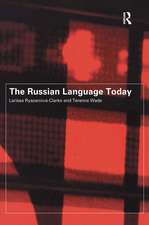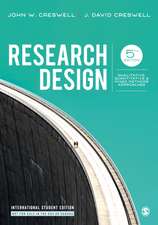Writing the Literature Review: A Practical Guide
Autor Sara Efrat Efron, Ruth Raviden Limba Engleză Paperback – 11 dec 2018
This accessible text provides a roadmap for producing a high-quality literature review--an integral part of a successful thesis, dissertation, term paper, or grant proposal. Each step of searching for, evaluating, analyzing, and synthesizing prior studies is clearly explained and accompanied by user-friendly suggestions, organizational tips, vignettes, and examples of student work. Also featured are excerpts from peer-reviewed quantitative, qualitative, and mixed methods articles. This is the first book to focus on crafting different types of reviews (systematic, traditional–narrative, or hermeneutic–phenomenological) that reflect the writer's research question, methodological choices, and approaches to knowledge. It describes what all reviews have in common and highlights distinct characteristics of each type. The book includes dos and don'ts for evaluating studies and constructing an argument, and software suggestions for locating, organizing, and arranging sources.
Pedagogical Features
*Checklists and "To Do" activities that break down key steps to take.
*Boxed examples, graphics that organize and visually illustrate key concepts, and summary tables.
*Group activities that invite students to further explore and apply the methods discussed in each chapter.
*Detailed directions for using four different organizing strategies: synthesis matrix, summary table, mapping, and topic outline.
*End-of-chapter summaries and "What's Next" sections.
*Assessment matrices for reviewing and refining the completed literature review.
Winner (First Place)--American Journal of Nursing Book of the Year Award, Nursing Research Category
Pedagogical Features
*Checklists and "To Do" activities that break down key steps to take.
*Boxed examples, graphics that organize and visually illustrate key concepts, and summary tables.
*Group activities that invite students to further explore and apply the methods discussed in each chapter.
*Detailed directions for using four different organizing strategies: synthesis matrix, summary table, mapping, and topic outline.
*End-of-chapter summaries and "What's Next" sections.
*Assessment matrices for reviewing and refining the completed literature review.
Winner (First Place)--American Journal of Nursing Book of the Year Award, Nursing Research Category
| Toate formatele și edițiile | Preț | Express |
|---|---|---|
| Paperback (1) | 316.70 lei 22-36 zile | |
| Guilford Publications – 11 dec 2018 | 316.70 lei 22-36 zile | |
| Hardback (1) | 502.88 lei 43-57 zile | |
| Guilford Publications – 14 noi 2018 | 502.88 lei 43-57 zile |
Preț: 316.70 lei
Nou
Puncte Express: 475
Preț estimativ în valută:
60.61€ • 62.89$ • 50.66£
60.61€ • 62.89$ • 50.66£
Carte disponibilă
Livrare economică 24 februarie-10 martie
Preluare comenzi: 021 569.72.76
Specificații
ISBN-13: 9781462536894
ISBN-10: 1462536891
Pagini: 298
Dimensiuni: 178 x 254 x 20 mm
Greutate: 0.45 kg
Ediția:1
Editura: Guilford Publications
Colecția Guilford Press
ISBN-10: 1462536891
Pagini: 298
Dimensiuni: 178 x 254 x 20 mm
Greutate: 0.45 kg
Ediția:1
Editura: Guilford Publications
Colecția Guilford Press
Cuprins
1. What Is a Literature Review?
2. Different Orientations to a Literature Review
3. Choosing a Review Topic and Formulating a Research Question
4. Locating and Organizing Research Sources
5. Selecting, Analyzing, and Keeping Notes of Sources
6. Evaluating Research Articles
7. Structuring and Organizing the Literature Review
8. Developing Arguments and Supporting Claims
9. Synthesizing and Interpreting the Literature
10. The Writer Voice and the Writing Process
11. Acknowledging Sources: Citations, Quotations, and Plagiarism
12. Putting It All Together
References
Index
2. Different Orientations to a Literature Review
3. Choosing a Review Topic and Formulating a Research Question
4. Locating and Organizing Research Sources
5. Selecting, Analyzing, and Keeping Notes of Sources
6. Evaluating Research Articles
7. Structuring and Organizing the Literature Review
8. Developing Arguments and Supporting Claims
9. Synthesizing and Interpreting the Literature
10. The Writer Voice and the Writing Process
11. Acknowledging Sources: Citations, Quotations, and Plagiarism
12. Putting It All Together
References
Index
Notă biografică
Sara Efrat Efron, EdD, is Professor of Education and Director of the Doctoral Program in Curriculum, Advocacy, and Policy at National Louis University. Her areas of interest include teacher research, mentoring, and moral and democratic education in times of crisis. Dr. Efron is coauthor, with Ruth Ravid, of Writing the Literature Review and Action Research in Education, Second Edition. She has published numerous book chapters and journal articles and presents widely at national and international conferences. She has also written several foreign-language instruction books for middle and high school students.
Ruth Ravid, PhD, is Professor Emerita of Education at National Louis University. Her areas of interest include educational research, action research, assessment, and school–university collaboration. Dr. Ravid has published numerous journal articles, book chapters, and books, including Writing the Literature Review and Action Research in Education, Second Edition, both coauthored with Sara Efrat Efron.
Ruth Ravid, PhD, is Professor Emerita of Education at National Louis University. Her areas of interest include educational research, action research, assessment, and school–university collaboration. Dr. Ravid has published numerous journal articles, book chapters, and books, including Writing the Literature Review and Action Research in Education, Second Edition, both coauthored with Sara Efrat Efron.
Recenzii
"The clarity of the text is a strength. The tables and examples of various orientations and approaches are very helpful, especially if students have heard critical comments about other academic areas’ research methods. The chapter on developing arguments and supporting claims (which includes common mistakes to avoid) is particularly instructive. I plan to begin using the book immediately--it is thorough, well written, and will be meaningful to graduate students and professionals.”--Marsha Harman, PhD, Psychology Program, Sam Houston State University
"This text adds a unique approach to writing the literature review; it is the only book on the topic that I have seen that connects the review to different research designs. As evidenced by the stories and scenarios throughout the book, it takes a learner-centered approach. I appreciate the use of graphic organizers as well as the chapter summaries in the form of numbered lists.”--Joyce Pittman, PhD, School of Education, Drexel University
"This is a wonderful book that is a very user-friendly and effective tool to teach students how to complete a professional literature review. It is easy to follow and targeted toward readers at all academic levels. Each chapter contains simply stated content and great examples, templates, checklists, and group exercises. The checklists and group exercises will be particularly useful to incorporate into in-class work to strengthen student learning.”--Kelli Larsen, PhD, Department of Social Work, Marshall University
"This is exactly the book my colleagues and I have been looking for. It thoroughly covers the processes that are important for students to grasp in conducting their literature reviews. Using this book will enable students to produce more rigorous and informed literature reviews than the basic summaries I often see. I like the figures that present information in a visual form as well as the ample examples, which set this book apart."--Stephanie J. Jones, EdD, College of Education, Texas Tech University
"A comprehensive, step-to-step guide, this book will be highly useful for master’s and doctoral students in social sciences and education. Students may feel intimidated by the task of writing a literature review, assuming they should already know how to do it and therefore not asking for guidance. The book could be used as a main textbook in academic writing classes or a supplementary source in research classes. It covers both fundamental issues, such as what a literature review is and what it is not, and more sophisticated topics--for example, the author’s voice and positionality, and the importance of revision."--Maja Miskovic, PhD, Professor of Research and Executive Director, Division of Research and Doctoral Programs, Concordia University Chicago
-Sometimes, wishful thinking comes too late in life….This easy-to-read, user-friendly book with step-by-step guides would have made an excellent companion for my experiences, both as a research writer and as an instructor….Efron and Ravid, like trailblazers and guides, have mapped out the whole process of research writing in easy steps in their book, Writing the Literature Review--making it easier and more comprehensible for researchers. They have defined parameters of each and every step of the journey….There is an abundance of information out there on literature review writing, but Efron and Ravid's book…is more distinct and conspicuous from the rest because of the simplicity with which this book is developed. I would highly recommend this easy-to-read book to all the instructors who teach Research Writing courses, and to all the graduate and doctoral students who are venturing out on their journey of the literature review writing processes.--Inquiry in Education, 4/1/2019"This text adds a unique approach to writing the literature review; it is the only book on the topic that I have seen that connects the review to different research designs. As evidenced by the stories and scenarios throughout the book, it takes a learner-centered approach. I appreciate the use of graphic organizers as well as the chapter summaries in the form of numbered lists.”--Joyce Pittman, PhD, School of Education, Drexel University
"This is a wonderful book that is a very user-friendly and effective tool to teach students how to complete a professional literature review. It is easy to follow and targeted toward readers at all academic levels. Each chapter contains simply stated content and great examples, templates, checklists, and group exercises. The checklists and group exercises will be particularly useful to incorporate into in-class work to strengthen student learning.”--Kelli Larsen, PhD, Department of Social Work, Marshall University
"This is exactly the book my colleagues and I have been looking for. It thoroughly covers the processes that are important for students to grasp in conducting their literature reviews. Using this book will enable students to produce more rigorous and informed literature reviews than the basic summaries I often see. I like the figures that present information in a visual form as well as the ample examples, which set this book apart."--Stephanie J. Jones, EdD, College of Education, Texas Tech University
"A comprehensive, step-to-step guide, this book will be highly useful for master’s and doctoral students in social sciences and education. Students may feel intimidated by the task of writing a literature review, assuming they should already know how to do it and therefore not asking for guidance. The book could be used as a main textbook in academic writing classes or a supplementary source in research classes. It covers both fundamental issues, such as what a literature review is and what it is not, and more sophisticated topics--for example, the author’s voice and positionality, and the importance of revision."--Maja Miskovic, PhD, Professor of Research and Executive Director, Division of Research and Doctoral Programs, Concordia University Chicago
Descriere
This accessible text provides a roadmap for producing a high-quality literature review--an integral part of a successful thesis, dissertation, term paper, or grant proposal. Each step of searching for, evaluating, analyzing, and synthesizing prior studies is clearly explained and accompanied by user-friendly suggestions, organizational tips, vignettes, and examples of student work. Also featured are excerpts from peer-reviewed quantitative, qualitative, and mixed methods articles.














